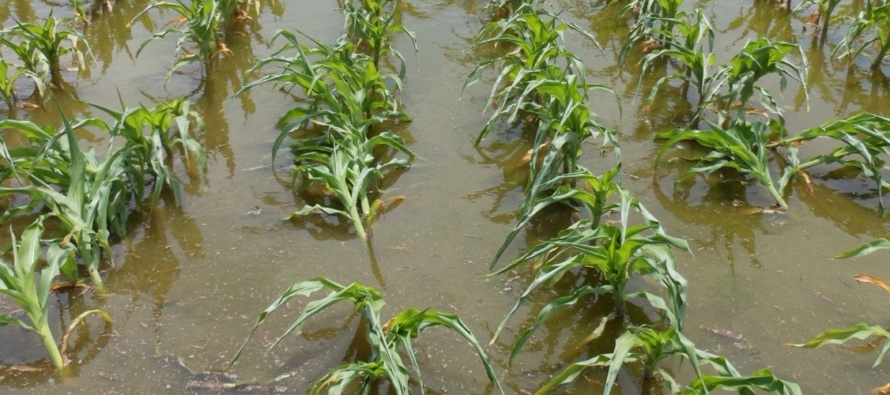Flooding in Corn and Soybeans

Related Articles
- 2010 Soybean And Corn Variety Trial Data 3
- 2010 Row Crop Short Course Video Links 0
- Exemption granted for Corn Seed Bird Repellent 0
Latest Tweets
By now I am sure everyone has seen the pictures of the flooding occurring from recent rains in across the river in Arkansas and Missouri. Compared to those states, Mississippi has fared pretty well in regards to flooding of young crops. Nonetheless, we thought that it would be a good idea to put out some information from previous research on the effects of flooding on corn and soybeans.
The majority of this post was prepared by Dr. Gurpreet Kaur, a post-doctoral researcher with me here in Stoneville. Dr. Kaur recently finished her Ph.D. at the University of Missouri and did a tremendous amount of work with flooding in corn and soybean for her degree. If you have any questions for her shoot her an email at gk340@msstate.edu.
I know this isn’t shocking to anyone, but flooding is bad for crops. Basically what happens when the soil becomes waterlogged the oxygen in the soil is rapidly depleted. Since oxygen is needed to perform several important plant processes, the lack of oxygen limits root growth, resulting (ironically) in decreased water uptake and nutrient uptake which limits growth and ultimately yield. Aside from soil waterlogging, other problems associated with flooding include deposition of soil and residue on the young crop plants which can physically damage young plants and increased susceptibility to a number of diseases.
Corn
Corn and soybeans are actually pretty different in their sensitivities to flooding. This is due to their growth habits. Up until around V6, the growing point for a corn crop is below the soil surface, meaning that corn is much more sensitive to flooding when it is little compared to when it gets bigger. Research out of Missouri showed that a 3-day flood at V6 reduced yield by 16%, while a 7-day flood reduced yield by 33%. However, a 1-day flood did not affect yield.
Looking at this figure we can see that in 2013 the researchers in Missouri observed a 6.6 bu/acre yield decrease for each day of flooding. That number increased to 11.4 bu/acre in 2014. This underscores the fact that the damage from the flooding event depends on the environmental conditions (air temperature, cloud cover, humidity) during and immediately after a flood occurs. Luckily, the majority of corn in the Delta is planted on lighter textured, sandy soils, so the chances of a prolonged flood are less likely. Generally, the plants that survive flooding will show new leaf growth in about three to five day after the flooding event with favorable temperatures.
Another problem with flooding in corn is the loss of nitrogen through nitrate leaching, runoff, and/or denitrification and additional N may need to be applied to a corn crop that has experienced a flooding event. Work with your consultant and/or Extension personnel to determine whether or not your corn needs additional nitrogen after a flooding event occurs. If you determine that your corn does need some more nitrogen, it is best to wait until the soil is dry before any top dress applications, and if you are using urea, it is a good idea to treat it with an NBPT product like Agrotain to reduce N loss through volatilization.
Soybeans
Unlike corn, young soybeans are generally pretty tolerant to flooding. Previous research out of Arkansas and Missouri has shown that soybeans are much more sensitive to flooding (and pretty much all other stresses) when they reach reproductive growth (R1-R2). Averaged across growth stages, the researchers saw ~2 bu/acre yield decrease for each day of flooding on clay soil and 1 bu/acre on silt-loam soils. Similar to corn, surviving soybean plants will usually resume growth in 3-5 days.
Soybeans can also have issues with nitrogen, but in a different way than corn. We all know that soybean get a big chunk of their nitrogen from symbiotic bacteria, Bradyrhizobium japonicum,
in the nodules that form on the soybean roots. Flooding can decrease nodule formation and can affect the functioning of existing nodules. Once the water leaves and the field dries out, populations of bacteria will usually rebound and nodulation will resume. It is relatively rare (I don’t expect any problems from this round of rain in Mississippi), but soybean can sometimes fail to nodulate. Soybean that don’t nodulate will look a sickly lime-green color not the deep dark green associated with a healthy soybean crop.
Nodulation begins around V2, but it takes a couple of weeks before the nodules begin to produce N for the soybean plant. Around V4 or V5 go out and dig up some soybeans to check for nodulation (actually dig, don’t just pull the plants out of the ground-this can break the nodules off). If you see nodules on the roots, then you are in good shape. However, if you fail to see nodules, that may be cause for concern. Keep checking the field, as sometimes nodules take longer to form based on soil conditions. If nodulation does fail, soybean can be fertilized with nitrogen, but they need A LOT of nitrogen and it is pretty expensive, so let’s just hope we don’t see any failures this year.
If you have questions about flooding in corn and soybean, please contact your local Extension staff.







Let me tell You a sad story ! There are no comments yet, but You can be first one to comment this article.
Write a comment